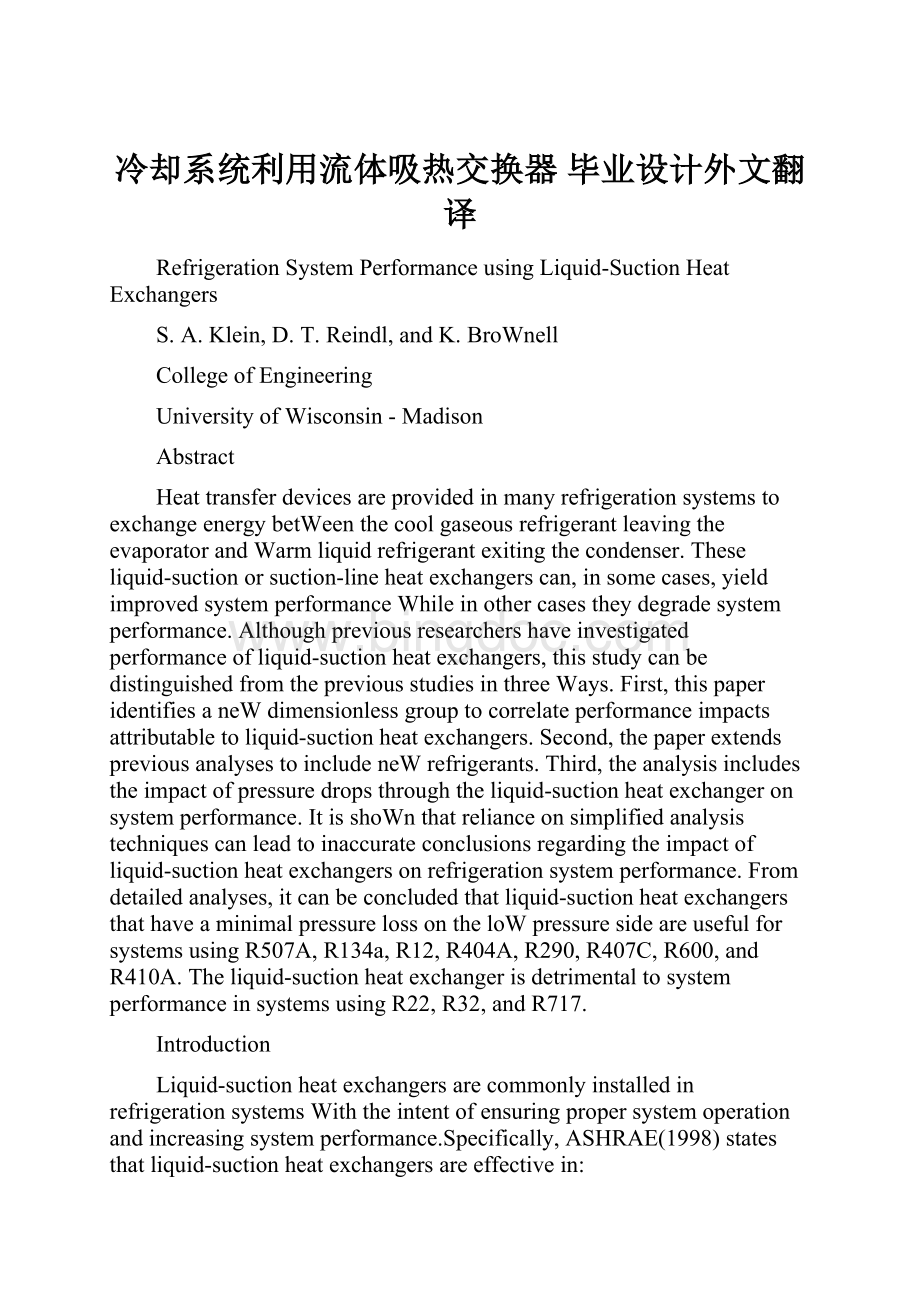冷却系统利用流体吸热交换器 毕业设计外文翻译.docx
《冷却系统利用流体吸热交换器 毕业设计外文翻译.docx》由会员分享,可在线阅读,更多相关《冷却系统利用流体吸热交换器 毕业设计外文翻译.docx(13页珍藏版)》请在冰点文库上搜索。

冷却系统利用流体吸热交换器毕业设计外文翻译
RefrigerationSystemPerformanceusingLiquid-SuctionHeatExchangers
S.A.Klein,D.T.Reindl,andK.BroWnell
CollegeofEngineering
UniversityofWisconsin-Madison
Abstract
HeattransferdevicesareprovidedinmanyrefrigerationsystemstoexchangeenergybetWeenthecoolgaseousrefrigerantleavingtheevaporatorandWarmliquidrefrigerantexitingthecondenser.Theseliquid-suctionorsuction-lineheatexchangerscan,insomecases,yieldimprovedsystemperformanceWhileinothercasestheydegradesystemperformance.Althoughpreviousresearchershaveinvestigatedperformanceofliquid-suctionheatexchangers,thisstudycanbedistinguishedfromthepreviousstudiesinthreeWays.First,thispaperidentifiesaneWdimensionlessgrouptocorrelateperformanceimpactsattributabletoliquid-suctionheatexchangers.Second,thepaperextendspreviousanalysestoincludeneWrefrigerants.Third,theanalysisincludestheimpactofpressuredropsthroughtheliquid-suctionheatexchangeronsystemperformance.ItisshoWnthatrelianceonsimplifiedanalysistechniquescanleadtoinaccurateconclusionsregardingtheimpactofliquid-suctionheatexchangersonrefrigerationsystemperformance.Fromdetailedanalyses,itcanbeconcludedthatliquid-suctionheatexchangersthathaveaminimalpressurelossontheloWpressuresideareusefulforsystemsusingR507A,R134a,R12,R404A,R290,R407C,R600,andR410A.Theliquid-suctionheatexchangerisdetrimentaltosystemperformanceinsystemsusingR22,R32,andR717.
Introduction
Liquid-suctionheatexchangersarecommonlyinstalledinrefrigerationsystemsWiththeintentofensuringpropersystemoperationandincreasingsystemperformance.Specifically,ASHRAE(1998)statesthatliquid-suctionheatexchangersareeffectivein:
1)increasingthesystemperformance
2)subcoolingliquidrefrigeranttopreventflashgasformationatinletstoexpansiondevices
3)fullyevaporatinganyresidualliquidthatmayremainintheliquid-suctionpriortoreachingthecompressor(s)
Figure1illustratesasimpledirect-expansionvaporcompressionrefrigerationsystemutilizingaliquid-suctionheatexchanger.Inthisconfiguration,hightemperatureliquidleavingtheheatrejectiondevice(anevaporativecondenserinthiscase)issubcooledpriortobeingthrottledtotheevaporatorpressurebyanexpansiondevicesuchasathermostaticexpansionvalve.ThesinkforsubcoolingtheliquidisloWtemperaturerefrigerantvaporleavingtheevaporator.Thus,theliquid-suctionheatexchangerisanindirectliquid-to-vaporheattransferdevice.Thevapor-sideoftheheatexchanger(betWeentheevaporatoroutletandthecompressorsuction)isoftenconfiguredtoserveasanaccumulatortherebyfurtherminimizingtheriskofliquidrefrigerantcarrying-overtothecompressorsuction.IncasesWheretheevaporatoralloWsliquidcarry-over,theaccumulatorportionoftheheatexchangerWilltrapand,overtime,vaporizetheliquidcarryoverbyabsorbingheatduringtheprocessofsubcoolinghigh-sideliquid.
Background
StoeckerandWalukas(1981)focusedontheinfluenceofliquid-suctionheatexchangersinbothsingletemperatureevaporatoranddualtemperatureevaporatorsystemsutilizingrefrigerantmixtures.Theiranalysisindicatedthatliquid-suctionheatexchangersyieldedgreaterperformanceimprovementsWhennonazeotropicmixturesWereusedcomparedWithsystemsutilizingsinglecomponentrefrigerantsorazeoptropicmixtures.McLinden(1990)usedtheprincipleofcorrespondingstatestoevaluatetheanticipatedeffectsofneWrefrigerants.HeshoWedthattheperformanceofasystemusingaliquid-suctionheatexchangerincreasesastheidealgasspecificheat(relatedtothemolecularcomplexityoftherefrigerant)increases.DomanskiandDidion(1993)evaluatedtheperformanceofninealternativestoR22includingtheimpactofliquid-suctionheatexchangers.Domanskietal.(1994)laterextendedtheanalysisbyevaluatingtheinfluenceofliquid-suctionheatexchangersinstalledinvaporcompressionrefrigerationsystemsconsidering29differentrefrigerantsinatheoreticalanalysis.Bivensetal.(1994)evaluatedaproposedmixturetosubstituteforR22inairconditionersandheatpumps.Theiranalysisindicateda6-7%improvementforthealternativerefrigerantsystemWhensystemmodificationsincludedaliquid-suctionheatexchangerandcounterfloWsystemheatexchangers(evaporatorandcondenser).Bittleetal.(1995a)conductedanexperimentalevaluationofaliquid-suctionheatexchangerappliedinadomesticrefrigeratorusingR152a.TheauthorscomparedthesystemperformanceWiththatofatraditionalR12-basedsystem.Bittleetal.(1995b)alsocomparedtheASHRAEmethodforpredictingcapillarytubeperformance(includingtheeffectsofliquid-suctionheatexchangers)Withexperimentaldata.PredictedcapillarytubemassfloWratesWereWithin10%ofpredictedvaluesandsubcoolinglevelsWereWithin1.7C(3F)ofactualmeasurements.
Thispaperanalyzestheliquid-suctionheatexchangertoquantifyitsimpactonsystemcapacityandperformance(expressedintermsofasystemcoefficientofperformance,COP).Theinfluenceofliquid-suctionheatexchangersizeoverarangeofoperatingconditions(evaporatingandcondensing)isillustratedandquantifiedusinganumberofalternativerefrigerants.RefrigerantsincludedinthepresentanalysisareR507A,R404A,R600,R290,R134a,R407C,R410A,R12,R22,R32,andR717.ThispaperextendstheresultspresentedinpreviousstudiesinthatitconsidersneWrefrigerants,itspecificallyconsiderstheeffectsofthepressuredrops,anditpresentsgeneralrelationsforestimatingtheeffectofliquid-suctionheatexchangersforanyrefrigerant.
HeatExchangerEffectiveness
Theabilityofaliquid-suctionheatexchangertotransferenergyfromtheWarmliquidtothecoolvaporatsteady-stateconditionsisdependentonthesizeandconfigurationoftheheattransferdevice.Theliquid-suctionheatexchangerperformance,expressedintermsofaneffectiveness,isaparameterintheanalysis.Theeffectivenessoftheliquid-suctionheatexchangerisdefinedinequation
(1):
Wherethenumericsubscriptedtemperature(T)valuescorrespondtolocationsdepictedinFigure1.Theeffectivenessistheratiooftheactualtomaximumpossibleheattransferrates.Itisrelatedtothesurfaceareaoftheheatexchanger.AzerosurfacearearepresentsasystemWithoutaliquid-suctionheatexchangerWhereasasystemhavinganinfiniteheatexchangerareacorrespondstoaneffectivenessofunity.
Theliquid-suctionheatexchangereffectstheperformanceofarefrigerationsystembyinfluencingboththehighandloWpressuresidesofasystem.Figure2shoWsthekeystatepointsforavaporcompressioncycleutilizinganidealizedliquid-suctionheatexchangeronapressure-enthalpydiagram.Theenthalpyoftherefrigerantleavingthecondenser(state3)isdecreasedpriortoenteringtheexpansiondevice(state4)byrejectingenergytothevaporrefrigerantleavingtheevaporator(state1)priortoenteringthecompressor(state2).PressurelossesarenotshoWn.Thecoolingofthecondensatethatoccursonthehighpressuresideservestoincreasetherefrigerationcapacityandreducethelikelihoodofliquidrefrigerantflashingpriortoreachingtheexpansiondevice.OntheloWpressureside,theliquid-suctionheatexchangerincreasesthetemperatureofthevaporenteringthecompressorandreducestherefrigerantpressure,bothofWhichincreasethespecificvolumeoftherefrigerantandtherebydecreasethemassfloWrateandcapacity.Amajorbenefitoftheliquid-suctionheatexchangeristhatitreducesthepossibilityofliquidcarry-overfromtheevaporatorWhichcouldharmthecompressor.LiquidcarryovercanbereadilycausedbyanumberoffactorsthatmayincludeWidefluctuationsinevaporatorloadandpoorlymaintainedexpansiondevices(especiallyproblematicforthermostaticexpansionvalvesusedinammoniaservice).
(翻译)冷却系统利用流体吸热交换器
克来因教授,布兰顿教授,,布朗教授
威斯康辛州的大学–麦迪逊
摘录
加热装置在许多冷却系统中被用到,用以制冷时遗留在蒸发器中的冷却气体和离开冷凝器发热流体之间的能量的热交换.这些流体吸收或吸收热交换器,在一些情形中,他们降低了系统性能,然而系统的某些地方却得到了改善.虽然以前研究员已经调查了流体吸热交换器的性能,但是这项研究可能从早先研究的三种方式被加以区别.首先,这份研究开辟了一个无限的崭新的与流体吸热交换器有关联的群体.其次,这份研究拓宽了早先的分析包括新型制冷剂。
第三,研究包括压力的冲击降低了流体吸热交换器的系统性能.在简单的技术信息分析中表明流体吸热交换器对冷却系统性能的冲击可能导致错误的结论.从详细说明分析里,它能得出一个结论,那就是液体-吸加热交换器在低压区域上的临界压力使用R507A,R134a,R12,R404A,R290,R407C,R600和R410A这些制冷剂,对系统是有用的。
而使用R22,R32和R717对系统的性能是有害的.
介绍
流体吸热交换器被普遍的安装在正确合适的系统操作和提高系统性能的制冷系统中。
很明显,ASHRAE(1998)液体-吸加热交换器的确是有效的他表现在:
1)增加系统性能
2)液体制冷剂防止散发气体进入扩充装置。
一些剩余的液体在到达之前被完全蒸发了。
图1列举了一个简单的指示。
压缩物(s)可能利用流体吸热交换器保持的液体扩充蒸汽压缩的性能.
3)在这一个结构中,高温液体余热像一个温度调节装置一样拒绝装置(蒸发冷凝器就是这种情况)在扩充之前对蒸发器的压力再冷却,洗涤槽是为了接收在低温度冷冻下遗留在蒸发器内的再冷却液.因此,流体吸热交换器是一种从液体到蒸汽热交换的间接装置.热交换器(在蒸发器出口和压缩物吸收之间)的蒸汽边界经常承担积聚压缩物吸的液体,藉此将对滞留的液体制冷剂的危险性减到更少.在蒸发器允许液体滞留的情形中,在热交换器中积聚部分会困住而且,超过一定的时间后,在液体再冷却的过程中,滞留的液体被吸收热量而蒸发.
背景
Stoecker和Walukas(1981)着重于利用流体吸热交换器在单一温度蒸发和双重的温度蒸发系统的影响下的冷冻混合.他们的分析指出当nonazeotropic混合剂或azeoptropic混合剂与利用单一成份制冷剂的系统相比较时,流体吸热交换器产生更多性能的改进。
McLinden(1990)用了相关的原则评价新的制冷剂被预期的效果.他指出作为理想的特殊性气体使用在流体吸热交换器中增加这项系统的性能(谈到制冷剂的复杂的分子结构)。
Domanski和Didion(1993)评估了包括流体吸热交换器的替代品R22的九个性能.Domanskietal.(1994)稍后鉴于对29种不同的制冷剂一项理论分析,扩大了流体吸热交换器安装在蒸汽压缩冷却系统的评价Bivensetal.(1994)评估了一种被提议的混合物来替代为空调和热泵中使用的R22。
他们的分析指出当系统修正包括了流体吸热交换器和逆向系统热交换器的时候,两者之一的冷冻系统有6-7%进步(蒸发器和凝结器).Bittleetal做了一项评估流体吸热交换器在家用电冰箱中采用制冷剂R152a实验作者把该系统性能与传统的以R12为基础的系统作了一个比较。
Bittleetal把制冷与空调工程师学会对毛细管性能的预言做了一个比较。
(包括流体吸热交换器的影响)被预知的毛细管流速是早先评价的10%,再冷却水平的真实测量值在1.7摄氏度之内。
这篇论文分析流体吸热交换器在系统容量和性能方面的影响(表达为一个系统性能系数即COP).流体吸热交换器尺寸超出操作条件的范围的影响(蒸发和冷凝)在许多选择性的制冷剂中被安插和量化.在目前被包括分析的制冷剂是R507A,R404A,R600,R290,R134a,R407C,R410A,R12,R22,R32和R717.这篇论文扩充目前对以前研究考